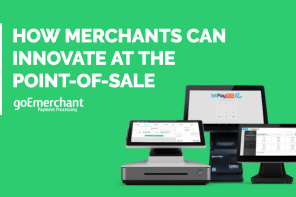The rise of affordable and innovative small business payment solutions has leveled the playing field between small companies and large corporations.
Instead of having to spend lots of money on solutions that are constantly needing to be upgraded, payment innovation has given businesses of all sizes access to the latest technology and same processing rates as the biggest players in the marketplace.
With that being said, many small business owners are content using old payment systems and outdated technology. If you want to break out of the status quo and embrace the future of tech, here are five payment trends you might want to consider.
SMB Payment Tech Trend No 1: Mobile POS
Mobile, mobile…mobile. We’re emphasizing this one because this trend is here to stick — in large part due to its ever-evolving possibilities. From mobile payment apps and integrated mobile payments to mobile POS terminals, small businesses can get quite a bit of bang for their buck by implementing a mobile payments strategy.
To start, mobile credit card processing is a way for small business to worry less about where they’re physically conducting business, and focus entirely on what type of payment experience they’re providing their customers. This includes features like the ability to text/email receipts and the opportunity to integrate better, faster and more secure payments.
Beyond the convenience perks, mobile POS solutions provide enhanced security measures to fully protect your business and your customer’s data. Ultimately, mobile payments give you that extra peace of mind.
SMB Payment Tech Trend No. 2: Digital Payments
Speaking of mobile, the next trend extends to the other side of the payment innovation equation: Digital payments. Consumers today are catching onto the latest payment trends, and many have begun ditching the need to pull out a credit card for every purchase. Digital payment methods have enabled faster, more secure payment processing that streamlines the online shopping journey.
Many big businesses caught onto digital payments years ago. Small businesses must follow suit if they want to find a competitive and stay ahead of what customers are expecting today. From in-app payments, one-click payment buttons and P2P payments, small businesses have a multitude of opportunities to take advantage of in order to better tailor their payment options for their customers.
As credit card breaches continue to dominate news headlines, consumers are looking toward companies that rely on better payment technology. Achieving this can be done using digital payment terminals that offer E2E encryption and tokenization. Digital payment methods extend the same security benefits, while also offer cardless ways to pay for products and services. For customers who don’t want to grab that credit card each time they make a purchase, integrating digital payment methods is a surefire way to fill that gap.
SMB Payment Tech Trend No. 3: APIs
APIs have often landed on the “I don’t have the tech team to think about APIs” list for small businesses. Luckily, with easier and more efficient integration options now in the market, SMBs can – and should – take full advantage of the power of APIs. Today, there are solutions that make accepting in-app and online payments easier than ever before.
Toolkits, drop-in code, and readily available tech support — like that provided by goEmerchant — is the type of technology that small businesses should be harnessing today. Payment processing services shouldn’t be restricted to what offerings your financial institution can provide to your business.
The API trend and recent innovation have helped small businesses integrate more dynamic payment processing features across all of their channels. This technology shift has also helped businesses connect their in-store and online software so that each system is in sync with the other.
SMB Payment Tech Trend No. 4: Open Banking Standards
The rise of the API economy has also paved the way for another major trend driven by technology innovation: Open banking. Small business payment processing services today have the benefit of linking to their necessary financial institution data through the use of APIs. Open banking APIs have turned the outdated financial system into a modern tech haven that is rich for innovative services for SMBs to take advantage of.
Open banking allows for a better customer experience since more businesses are able to take advantage of the latest financial technology available in the market. With more transparency in the financial ecosystem, open banking has also created a level playing field for developers and ISVs to utilize solutions that better incorporate financial services into more unified, dynamic payments platforms.
SMB Payment Tech Trend 5: Automation
Another key trend that businesses should take advantage of is the ability to automate services — including payments. From recurring billing to subscription services, small businesses can find tons of undiscovered value by leveraging automation to streamline payment processing.
Automation can also help businesses better connect with their customers. Having the ability to regularly communicate with your customer base is one of the best ways a small business can stay top of mind. Customers aren’t always going to remember to come back to your physical or online storefronts — you’ll need to nudge them with reminders. Regular communication can be automated to help you reach customers without investing heavily into mass advertising platforms.
On the payment processing side, businesses that already leverage recurring billing services have learned the power of automated payments. Not only does this help keep consistent revenue flowing into your business, it can help keep your best customers loyal to your brand. Consumers are eager to regularly engage with their favorite brands, products, and services, but often forget to do so. Solve that by taking the hassle out of the process and offer your customers a way to become a subscriber. They remain connected to your brand, and you continually get paid. That’s a payment tech trend that’s certainly here to stay.




